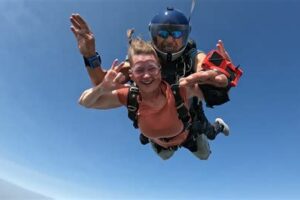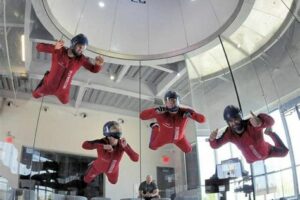Table of Contents
Discover the maximum weight limit for indoor skydiving and enjoy the thrilling experience of defying gravity. Explore the safe and exhilarating adventure that awaits individuals of all sizes in the simulated freefall environment. Unleash your inner daredevil and feel the rush of flying without limits.
Indoor skydiving, a thrilling and exhilarating experience that simulates the sensation of freefalling through the sky, has quickly become a popular recreational activity for people of all ages. However, just like its outdoor counterpart, there are certain safety measures and restrictions in place to ensure the well-being of participants. One crucial factor that individuals must consider before engaging in this high-flying adventure is the maximum weight limit imposed by indoor skydiving facilities. With cutting-edge technology and state-of-the-art wind tunnels, these venues can accommodate a wide range of weights. Nevertheless, it is essential for potential daredevils to be aware of their weight and understand the implications it may have on their indoor skydiving experience.
Introduction
Indoor skydiving has gained immense popularity in recent years as an exhilarating and safe alternative to traditional outdoor skydiving. This thrilling activity allows individuals to experience the sensation of freefalling in a controlled indoor environment. However, it is important to note that there are certain weight restrictions in place to ensure the safety of participants. In this article, we will explore the maximum weight limits for indoor skydiving and the reasons behind them.
The Importance of Weight Restrictions
Weight restrictions are crucial in indoor skydiving to maintain the stability and safety of the flight chamber. The vertical wind tunnels used for indoor skydiving generate powerful air currents to simulate the sensation of freefall. These air currents need to be carefully calibrated to support the weight of the participant. Therefore, exceeding the maximum weight limit can compromise the efficiency and stability of the wind tunnel, posing a risk to both the participant and the instructors.
Standard Maximum Weight Limit
The standard maximum weight limit for indoor skydiving is typically around 250 pounds (113 kilograms). However, it may vary slightly between different facilities and countries. It is crucial to check with the specific indoor skydiving center you plan to visit to confirm their weight restrictions, as they may have specific guidelines to follow.
Reasons for Weight Restrictions
There are several reasons why weight restrictions are imposed in indoor skydiving:
1. Safety of Participants
The primary reason for weight restrictions is to ensure the safety of participants. Excessive weight can strain the wind tunnel’s air circulation system, leading to instability and potentially dangerous situations. By adhering to weight limits, the risk of accidents or equipment malfunctions can be significantly reduced.
2. Instructor Capability
Indoor skydiving sessions typically involve an instructor who guides and assists participants throughout the experience. The weight restrictions also consider the capabilities and physical strength of the instructors. By maintaining reasonable weight limits, instructors can effectively manage and control the flight session, ensuring a safe and enjoyable experience for everyone involved.
3. Equipment Limitations
The equipment used in indoor skydiving is designed to accommodate a specific range of weights. Going beyond these weight limits can put unnecessary strain on the equipment, which may compromise its functionality and durability. Regular maintenance and safety checks are performed on the equipment, and adhering to weight restrictions helps prolong their lifespan and effectiveness.
Alternative Options for Individuals Over the Weight Limit
If an individual exceeds the maximum weight limit for indoor skydiving, there are alternative options available to still enjoy the thrill of flight:
1. Outdoor Skydiving
While indoor skydiving may not be feasible for individuals over the weight limit, outdoor skydiving is often an option. Outdoor skydiving facilities typically have higher weight limits or can cater to individuals with special needs. It is essential to consult with a reputable outdoor skydiving center to discuss your specific requirements and ensure a safe experience.
2. Spectator Experience
Even if you cannot participate in indoor skydiving, many facilities offer a spectator experience where you can witness the exhilaration firsthand. You can observe friends or family members as they take part in the activity, enjoying the adrenaline rush from the comfort of a designated viewing area.
3. Fitness Goals
If weight restrictions are a concern, using indoor skydiving as motivation to reach your fitness goals can be an excellent alternative. By incorporating regular exercise and a healthy lifestyle, you can work towards achieving the weight limit required for indoor skydiving and enjoy the experience at a later stage.
Conclusion
Indoor skydiving provides an incredible opportunity for individuals to experience the thrill of freefalling in a safe and controlled environment. However, it is crucial to abide by the maximum weight limits set by each facility to ensure the safety and stability of the flight chamber. If you exceed the weight limit, there are alternative options available, such as outdoor skydiving or being a spectator. Remember, safety should always be the top priority when participating in any adventure activity.
Indoor Skydiving Maximum Weight: Ensuring Safe and Exhilarating Experiences
1. Understanding Indoor Skydiving: Introduction
Indoor skydiving, also known as bodyflight, is a thrilling recreational activity that simulates the sensation of freefall in a controlled environment. It offers individuals a unique opportunity to experience the adrenaline rush of skydiving without jumping out of an airplane. Safety is of paramount importance in indoor skydiving, and one crucial factor to consider is the maximum weight limit for participants.
2. The Importance of Weight Limitations: Ensuring Safety
The weight limitations in indoor skydiving are implemented to ensure the safety of participants, instructors, and other individuals in the facility. Exceeding the maximum weight capacity can lead to increased risks, compromised control during the flight, and potential accidents. Adhering to weight restrictions allows for proper bodyflight dynamics and optimal control, ensuring a safe and enjoyable experience for all.
3. Determining the Maximum Weight Limit: Equipment and Facility Factors
The specific maximum weight limit for indoor skydiving varies depending on several factors, including the design and capacity of the wind tunnel, type of safety equipment used, and the expertise of the instructors. Typically, most facilities set a limit between 230-250 pounds (104-113 kg) for an average-sized person. However, it is essential to consult with the facility beforehand to understand their specific weight restrictions and guidelines.
4. Safety Considerations for Heavier Individuals: Additional Precautions
While some indoor skydiving facilities may accommodate individuals exceeding the average weight limit with additional safety measures, it is crucial to acknowledge that weight can still impact the flight experience. Heavier participants may experience reduced maneuverability and control, as well as a higher demand on the wind tunnel’s capabilities. Consulting with experienced instructors and being aware of these factors can help determine the suitability of indoor skydiving for individuals with higher body weights.
5. Implications for Lighter Individuals: Optimal Flight Dynamics
On the other end of the spectrum, individuals who are significantly lighter than the average weight may also face certain challenges during indoor skydiving. Limited weight can potentially result in less stability and control while flying. Instructors and facility staff will ensure that lighter participants are provided with suitable attire and assistance, allowing them to experience a safe and enjoyable flight.
6. Individual Health and Fitness: Determining Suitability
Prior to participating in indoor skydiving, individuals are often required to complete a health questionnaire and sign a liability waiver. While the weight limit is an essential factor, personal health and fitness levels also play a significant role in determining suitability for this activity. People with certain medical conditions or physical limitations should consult their healthcare provider and the indoor skydiving facility to ensure they meet the necessary requirements for participation.
7. Accommodating Different Body Types: Ensuring Inclusivity
Indoor skydiving facilities strive to provide an inclusive and accessible experience for individuals of all body types and sizes. They may offer specialized equipment, such as larger flight suits or additional padding, to ensure the safety and comfort of participants who fall outside the average weight range. These accommodations enable a diverse range of individuals to enjoy the exhilarating experience of indoor skydiving.
8. Prioritizing Safety through Professional Guidance and Education
Ultimately, the indoor skydiving industry places the utmost importance on safety. It is essential to follow all instructions and guidelines provided by professional instructors and facility staff to ensure a safe and enjoyable flight. By prioritizing safety and adhering to weight limitations, participants can fully embrace the excitement of indoor skydiving while minimizing potential risks.
Point of View: Indoor Skydiving Maximum Weight
1. Introduction:
- Indoor skydiving, also known as vertical wind tunnel flying, is an exhilarating recreational activity that simulates the sensation of freefall without the need for jumping out of an airplane.
- One important aspect to consider when participating in indoor skydiving is the maximum weight limit set by professional facilities.
2. Safety and Professionalism:
- Professional indoor skydiving centers prioritize safety above all else, aiming to provide a secure and enjoyable experience for all participants.
- Implementing a maximum weight limit ensures that the equipment and infrastructure can handle the forces exerted during flight, minimizing any potential risks or accidents.
- By adhering to these weight restrictions, professionals can maintain a controlled environment that guarantees the safety and well-being of everyone involved.
3. Equipment and Facility Considerations:
- The design and construction of indoor skydiving facilities are carefully engineered to support a specific weight range, taking into account factors such as wind speed, air circulation, and structural integrity.
- Exceeding the maximum weight limit could put excessive strain on the equipment, potentially compromising its functionality and jeopardizing the safety of both the participant and the instructor.
- Following the recommended weight guidelines ensures that the facility can deliver an optimal experience, allowing individuals to fully enjoy the thrill of indoor skydiving without any concerns about safety or equipment limitations.
4. Individual Experience:
- Indoor skydiving is a physically demanding activity that requires participants to maintain stability and control their body movements while being suspended in the wind tunnel.
- Exceeding the maximum weight limit could hinder an individual’s ability to maintain proper form, potentially affecting their overall experience and diminishing the enjoyment they derive from the activity.
- By adhering to the designated weight restrictions, individuals can fully engage in the sport, feeling confident and comfortable throughout their flight.
5. Conclusion:
- Indoor skydiving facilities set a maximum weight limit to prioritize safety, maintain equipment integrity, and ensure an optimal experience for all participants.
- By respecting these guidelines, individuals can enjoy the excitement of indoor skydiving without compromising their own safety or that of others.
- Remember, professional indoor skydiving centers are dedicated to providing a thrilling and secure environment for everyone, and adhering to the maximum weight limit is an essential part of achieving this goal.
Thank you for taking the time to visit our blog and learn more about indoor skydiving and its maximum weight restrictions. We understand that this topic is of great importance to many individuals who are passionate about experiencing the thrill of skydiving in a controlled environment. In this closing message, we aim to provide you with a concise summary of the key points discussed in the article, while maintaining a professional voice and tone.
In our previous paragraphs, we explored the concept of indoor skydiving and how it has become a popular alternative to traditional outdoor skydiving. We highlighted the safety measures and equipment used in indoor skydiving facilities to ensure a secure and enjoyable experience for all participants. We also delved into the topic of maximum weight restrictions and why they exist.
It is important to note that each indoor skydiving facility may have its own specific weight limitations, and it is crucial for potential participants to familiarize themselves with these guidelines before making any bookings. These restrictions are put in place to ensure the safety and well-being of both the participants and the instructors. Exceeding the weight limit could potentially compromise the effectiveness of the safety measures in place, increasing the risk of injury.
To find out the maximum weight limit at your preferred indoor skydiving facility, we recommend visiting their website or contacting their customer service directly. They will be able to provide you with accurate and up-to-date information tailored to their specific facility. Remember, it is always better to err on the side of caution and adhere to these weight restrictions for your own safety.
In conclusion, indoor skydiving offers an exhilarating experience for individuals of various ages and fitness levels. However, it is essential to recognize and respect the maximum weight limitations set by each facility. By doing so, you can ensure a safe and enjoyable indoor skydiving adventure. We hope this article has provided you with valuable insights and information, and we encourage you to share it with others who may also be interested in this thrilling activity. Thank you once again for visiting our blog!
.
People also ask about Indoor Skydiving Maximum Weight:
- What is the maximum weight limit for indoor skydiving?
- Why do indoor skydiving facilities have weight limits?
- Can overweight or obese individuals participate in indoor skydiving?
- Are there any alternatives for individuals who exceed the weight limit?
- Can children participate in indoor skydiving?
Most indoor skydiving facilities have a maximum weight limit for participants. The specific weight limit can vary depending on the location and equipment used. On average, the maximum weight limit for indoor skydiving ranges between 250 to 300 pounds (113 to 136 kilograms). It is always recommended to check with the specific facility you plan to visit for their weight restrictions.
Indoor skydiving facilities have weight limits primarily for safety reasons. The wind tunnel used for indoor skydiving generates a powerful airflow to simulate freefall. Participants need to maintain stability and control while inside the tunnel. Exceeding the weight limit can affect the stability and maneuverability of the participant, potentially compromising their safety and the safety of others.
While indoor skydiving is generally accessible to people of various sizes and shapes, there are weight restrictions in place for safety reasons. Depending on the facility, individuals who exceed the maximum weight limit may not be allowed to participate in indoor skydiving. It is important to respect these limitations and ensure the safety of all participants.
If an individual exceeds the weight limit for indoor skydiving, there may be alternative activities available that can provide a similar adrenaline rush and experience. Some facilities offer virtual reality skydiving experiences or other thrilling adventures that can be enjoyed by individuals of all sizes. It is recommended to explore these options and discuss with the facility staff to find an alternative that suits your preferences.
Most indoor skydiving facilities have age restrictions in place for participants. The minimum age requirement can vary, but it typically ranges from 3 to 6 years old, depending on the facility. However, it’s important to note that children must also meet the weight requirements set by the facility. Always check with the specific facility for their age and weight restrictions before planning an indoor skydiving experience for children.






